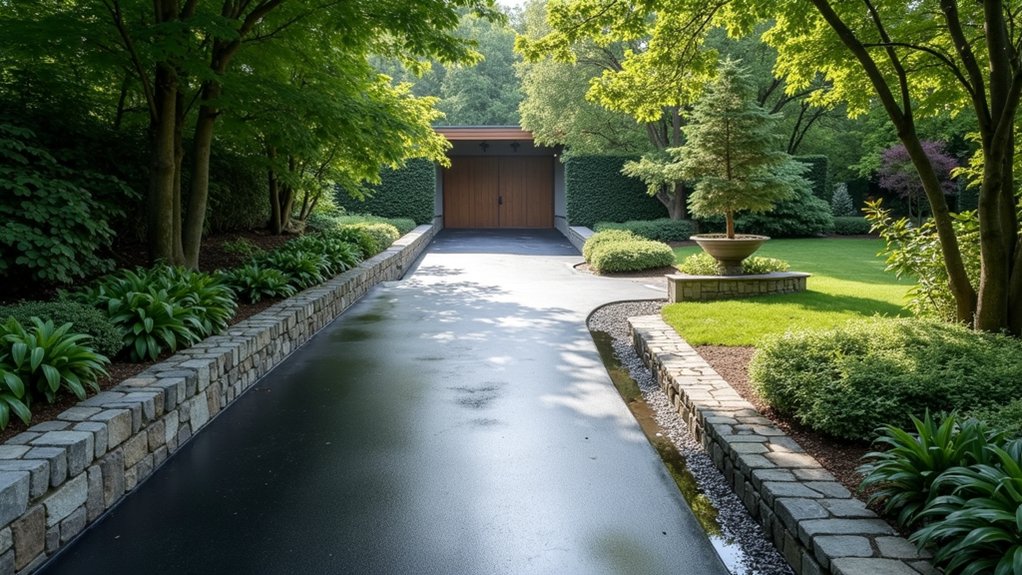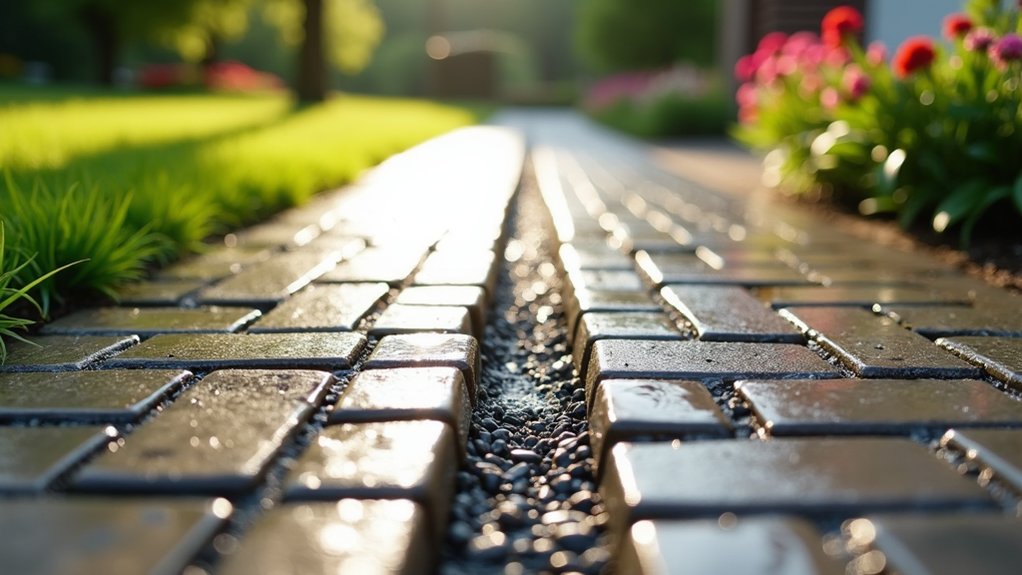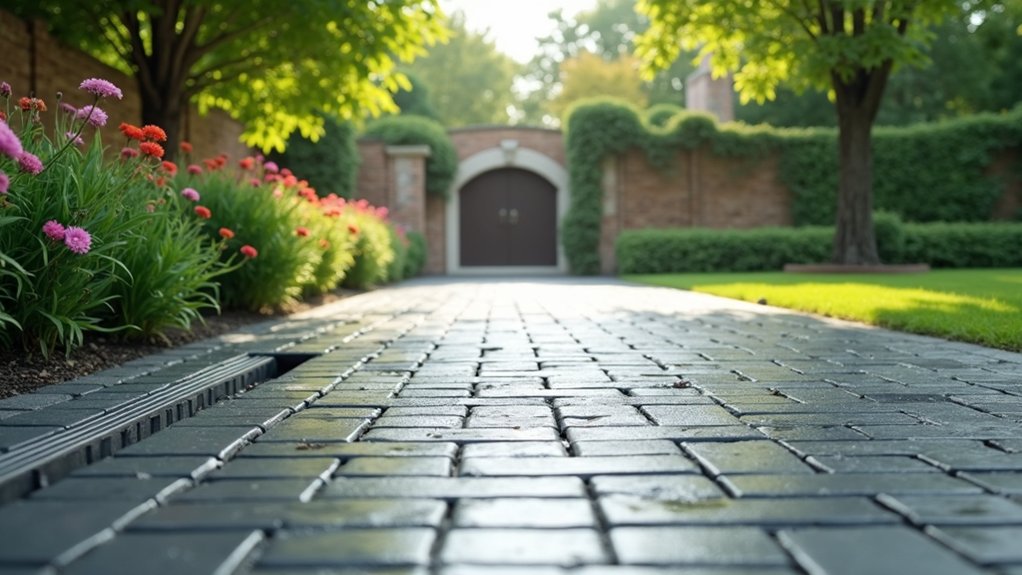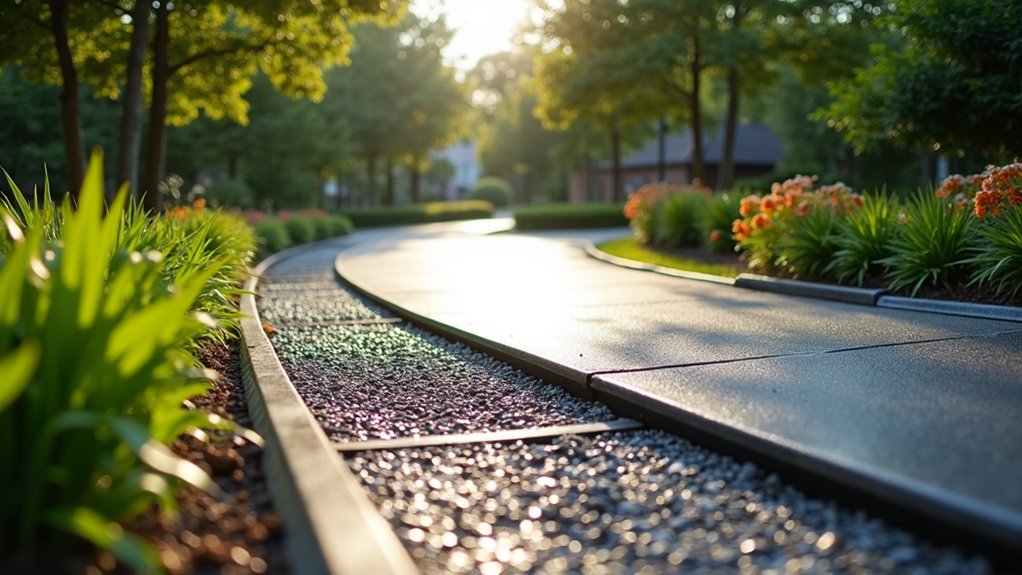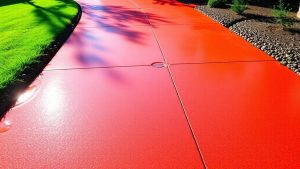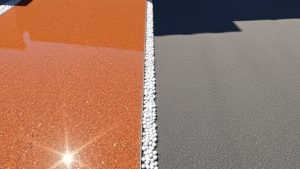Yes, driveways require proper drainage to ensure their durability and prevent water damage. In the UK, regulations state that any driveway over 5m² must have a drainage solution, unless permeable materials are used. Effective drainage systems, like channel drains or soakaways, help redirect water away from the surface, minimising erosion and keeping your driveway looking its best. Regular inspections and maintenance can further improve the performance of your drainage system. For more insights on the best practices and suitable materials for optimal driveway drainage, consider exploring additional resources.
Table of Contents
ToggleKey Takeaways
- Proper drainage is vital for the longevity of your driveway, as it helps prevent cracks and structural problems caused by water pooling.
- In the UK, regulations stipulate that driveways larger than 5m² must have drainage solutions unless permeable materials are used to manage rainwater effectively.
- Consider effective drainage options like channel drains or French drains, which should be designed with the slope and flood risk in mind.
- Regular maintenance, including inspections and clearing blockages, is essential to keep your drainage system working properly.
- Following local regulations and implementing good drainage design not only improves your driveway’s functionality but also promotes sustainable practices.
Importance of Driveway Drainage

When it comes to the longevity and functionality of your driveway, proper drainage is crucial. Without effective drainage solutions, water can pool on the surface, leading to significant wear and tear. This not only detracts from the visual appeal but also increases the risk of cracks and potholes, which can pose safety hazards. Furthermore, if water seeps into the underlying layers, it can create structural issues that lead to costly repairs. The benefits of good drainage are clear: it prevents water accumulation and reduces erosion, safeguarding both your driveway and your property’s foundation. Additionally, proper drainage systems are essential for longevity, ensuring that moisture does not compromise the integrity of your driveway materials. Implementing SuDS drainage solutions can further enhance this effectiveness by promoting natural water absorption and preventing flooding.
Regulatory Requirements for Driveway Drainage
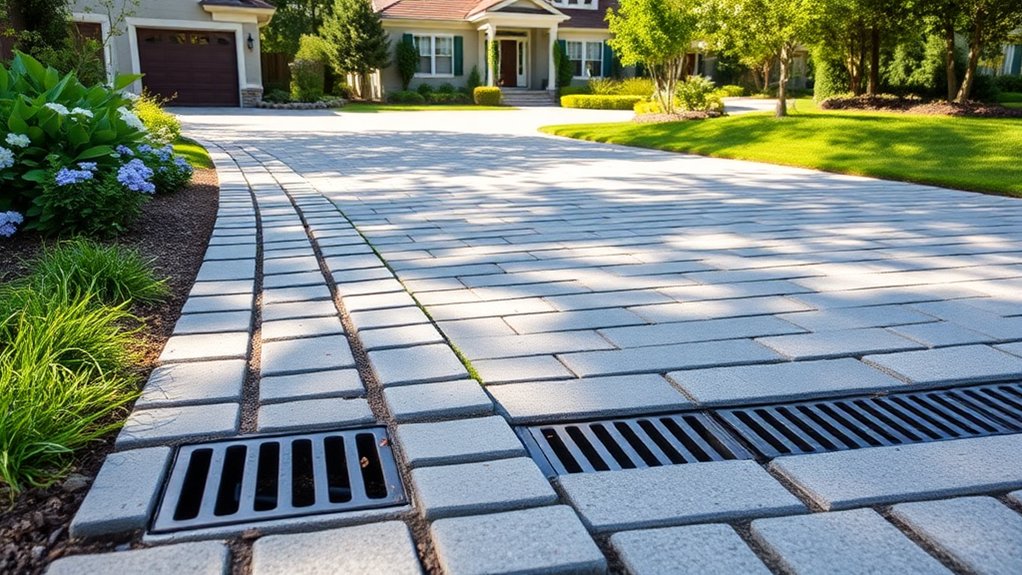
When planning your driveway, it’s crucial to be aware of the regulatory requirements for drainage in your area.
In the UK, specific planning regulations require drainage solutions based on the size and material of your driveway. For example, if you’re installing a large paved driveway, you may need to incorporate permeable materials or a drainage system to manage rainwater effectively. Effective drainage solutions are necessary to prevent potholes and erosion, which can arise from improper water management. Additionally, ensuring that your base is stable is fundamental for achieving long-lasting resin driveway performance, as it directly affects the effectiveness of the drainage system.
Adhering to these standards not only keeps you compliant with the law but also helps prevent flooding and water pooling on your property.
UK Drainage Regulations
Understanding UK drainage regulations is crucial for anyone considering a driveway installation, as there are specific legal requirements to effectively manage surface water runoff.
Here are the key points to remember:
- Legal Requirement: Under the Building Regulations 2010, Part H, driveways must have drainage solutions in place.
- Area Threshold: If your new driveway covers more than 5m², you must implement a drainage solution. However, if you use permeable materials, you can bypass this requirement. The use of permeable surfaces like resin bound driveways can significantly reduce runoff.
- Approved Solutions: Suitable options include permeable surfaces, soakaways, and drainage channels, all designed to manage water effectively. Additionally, non-permeable driveway materials over 5m² require a drainage system to prevent flooding and erosion.
- Compliance Checks: Local authorities may assess installations to ensure they meet the regulations.
Implementing these drainage solutions helps prevent flooding, improves water quality, and supports sustainable practices.
Always check with your local council for specific requirements relevant to your area.
Permitting and Planning Requirements
Before commencing any driveway drainage project, it’s crucial to understand the permitting and planning requirements that may apply. Depending on the size of your project, you may need to obtain municipal permits, particularly for larger installations or significant alterations.
If you live in a residential area governed by a homeowners’ association (HOA), be aware that they may have specific regulations regarding drainage aesthetics.
Should your project impact public rights-of-way or utilities, expect additional scrutiny from local authorities. While minor changes may not require formal permissions, substantial modifications often necessitate engineering reviews.
Local regulations may also specify approved materials, often favouring permeable options to effectively manage drainage runoff.
To ensure compliance, maintain proper grading and erosion control, and be prepared for inspections to confirm adherence to your plans.
It’s wise to keep records of any permits obtained, as these can be useful for future projects or insurance purposes.
Typical Drainage Features and Design

When designing drainage for a driveway, it’s essential to adhere to minimum slope requirements to ensure effective water flow.
Consider using permeable materials, like gravel or permeable paving, to improve water absorption and minimise runoff.
These features work together to create a reliable system that helps prevent flooding and ensures efficient drainage.
Minimum Slope Requirements
Establishing the correct minimum slope requirements for driveways is crucial for effective drainage and safety. Following specific guidelines helps prevent water pooling and enhances the driveway’s longevity.
Here are the key points to consider:
- Maximum Slope: Keep the slope below 20% to avoid accidents.
- Preferred Slope: An 8:1 slope is ideal for ensuring proper drainage from the edge of the pavement.
- Typical Slope Range: Aim for a slope between 5% and 15% to strike a balance between safety and drainage.
- Design Guidelines: Always check local regulations, as requirements can differ across regions.
Effective Water Direction
Effective water direction is crucial for maintaining the integrity of driveways. Poor drainage can cause issues like water pooling and structural damage. By using advanced drainage solutions, you can effectively manage water and prevent these problems.
| Drainage Feature | Purpose |
|---|---|
| Trench Drains | Collect and redirect water from sloped areas |
| Channel Drains | Capture water on slightly sloped driveways |
| French Drains | Distribute and redirect water efficiently |
| Landscaping Swales | Channel water into areas where it can be absorbed by soil |
When designing your drainage system, pay attention to placement, pipe management, and how it fits into the landscape. Each feature can be tailored to suit your driveway type, ensuring optimal performance while adhering to local regulations.
Permeable Material Integration
Integrating permeable materials into driveway design provides a sustainable approach to water management. Using these materials offers notable benefits for drainage and promotes environmentally friendly practices.
Here are key features that enhance drainage:
- Porous materials allow water to seep through, minimising surface runoff.
- Interlocking designs direct water through gaps, improving drainage efficiency.
- Angular gravel infill enhances permeability and aids in stormwater storage.
- Multi-layer systems ensure effective drainage with a gravel base and filter.
These features assist in managing stormwater and meet local regulations.
Material Choices Impacting Drainage
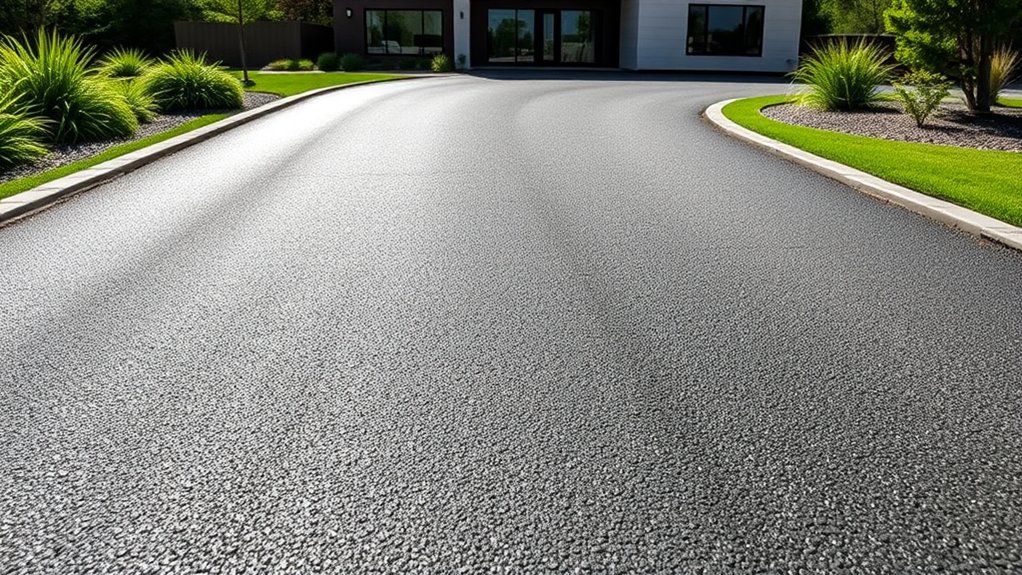
When choosing materials for a driveway, it’s important to consider how they affect drainage. Gravel is a great option as it allows water to drain quickly and requires minimal upkeep, helping to prevent puddles.
On the other hand, traditional materials like asphalt and concrete create solid surfaces that lead to increased runoff.
Pavers are beneficial too; their interlocking design not only provides stability but also promotes water drainage.
Pervious concrete is another effective choice, known for its high drainage capacity, which can help manage flooding risks.
Selecting the right material enhances your driveway’s look and is crucial for effective water management, ensuring durability and environmental sustainability.
Planning and Permitting for Drainage Systems

When planning your driveway drainage system, it’s crucial to understand the permit requirements to comply with local regulations.
You’ll need to navigate the design approval process, which typically involves submitting detailed plans that adhere to specific criteria.
If you neglect these steps, you could face costly delays or rejections, which may affect the overall timeline of your project.
For instance, if your plans don’t meet the local council’s drainage standards, you may have to start over, wasting both time and money.
Permit Requirements Overview
Understanding the permit requirements for drainage systems is crucial, as regulations can differ significantly depending on your location and the type of system you plan to install. Here are some key points to consider:
- Types of Permits: Determine whether you need specific permits, such as a drainage connection permit or a general construction permit, based on your project’s scale.
- Exemptions: In some cases, small residential projects may not require permits if they don’t significantly change drainage patterns.
- Environmental Assessments: Larger projects may need environmental assessments to ensure they comply with regulations that protect local ecosystems.
- Local vs. National Regulations: Be mindful that national permits may not align with local requirements, particularly for projects affecting roads or waterways.
Being aware of these aspects will help you plan effectively and ensure compliance.
Design Approval Process
Before starting any driveway drainage project, you need to follow a straightforward design approval process that meets local, regional, and national regulations.
Begin by submitting detailed plans that include essential design elements, such as hydrological assessments and specific site conditions. Ensure your designs use effective drainage solutions to manage runoff and adhere to stormwater management standards.
Approval often involves working with local councils or transport authorities, with a focus on safety and the impact on nearby infrastructure.
Pay special attention to environmental issues, especially in areas prone to flooding, and consider the locations of utilities during your planning.
It’s crucial to secure a fully executed permit before construction starts, ensuring that all aspects of your drainage system meet the relevant regulations and standards.
Best Practices for Driveway Drainage Installation

Properly installing a driveway drainage system is crucial for preventing water build-up and protecting your property.
To get the best results, follow these best practices:
- Select the Right System: Choose drainage solutions like channel drains or French drains based on your driveway’s slope and potential flood risk.
- Position Wisely: Install drains at the lowest points near garages or entrances to prevent water pooling.
- Ensure Proper Gradient: Maintain a slope of at least 1% for every 8 feet to ensure effective water flow.
- Use Robust Materials: Go for durable options like concrete, gravel, or PVC pipes that combine functionality with a pleasing appearance.
Soil and Runoff Analysis Before Installation
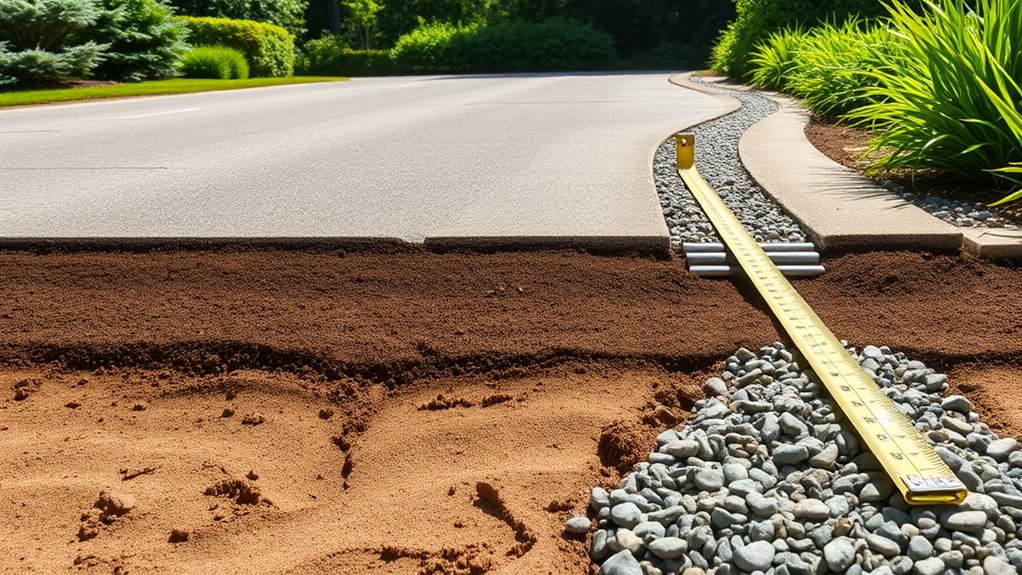
Before installing driveway drainage, it’s crucial to carry out a thorough analysis of the soil and runoff.
Start by identifying the types of soil present and assessing their moisture levels, as these directly influence drainage effectiveness. For example, sandy soils typically drain better than clay soils, which can retain water.
Next, evaluate the slope of your property to ensure water flows away from buildings, thereby reducing the risk of erosion.
It’s important to plan effective drainage paths to manage runoff and minimise pooling.
Also, make sure the subgrade is properly compacted to support the driveway and prevent settling over time.
Common Drainage Solutions for Driveways

When considering drainage solutions for driveways, it’s important to assess the specific needs of your property, as various methods address different issues.
Here are some effective drainage systems to consider:
- Channel Drains: These are narrow drains fitted with grates that efficiently collect surface water.
- Catch Basins: These in-ground systems help redirect water away from your driveway.
- French Drains: These consist of trenches filled with gravel and perforated pipes to manage excess water.
- Permeable Pavers: These allow water to seep through, reducing surface runoff.
Each solution can be customised to fit your driveway’s design and local drainage needs, helping to prevent erosion and flooding on your property.
Maintenance of Driveway Drainage Systems
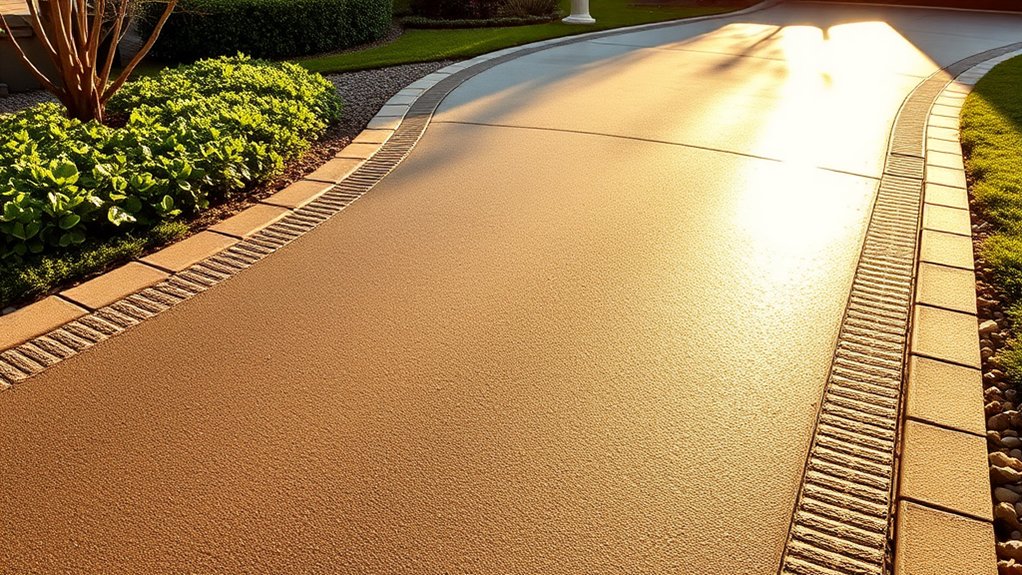
To ensure your driveway drainage system operates effectively, regular maintenance is crucial. Aim to schedule inspections at least once a year, or every six months for older systems or in areas with heavy debris.
Check for any build-up of leaves and dirt, ensuring grates and channels are clear to allow proper water flow. After heavy rainfall, evaluate how well the system manages runoff and look for any blockages.
Flushing the system periodically helps remove sediment, with frequency depending on local conditions. Keep a detailed record of all maintenance work for future reference.
Address any structural problems, like cracks or rust, without delay. By maintaining a routine inspection schedule, you can enhance the lifespan and efficiency of your driveway drainage system.
Impact of Local Regulations on Drainage Practices
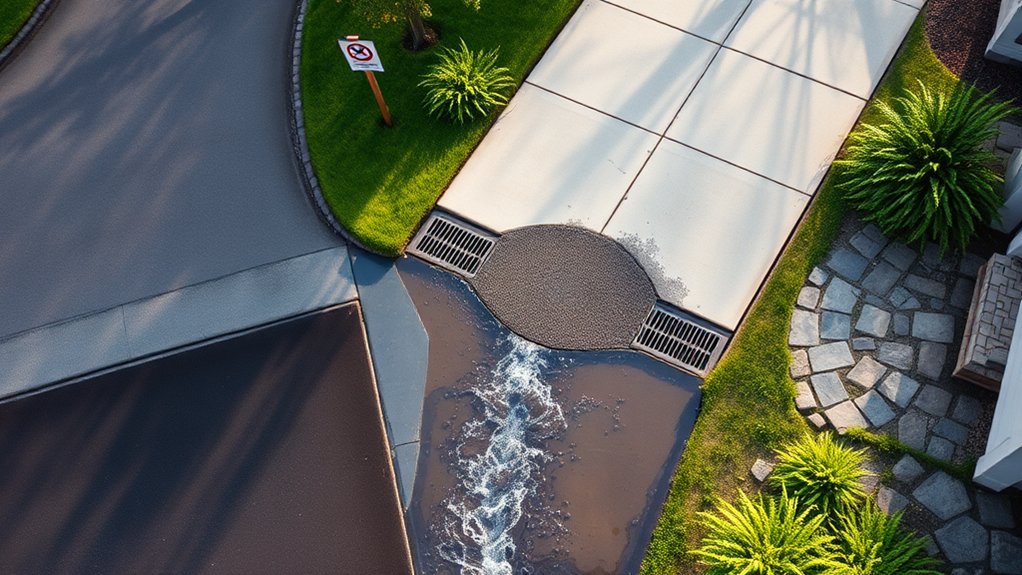
Local regulations significantly influence drainage practices for driveways in the UK, affecting design, materials, and installation techniques.
It’s essential to be aware of these local codes and drainage standards to ensure compliance. Here are the key points to consider:
- Local bylaws determine how drainage systems must be designed to ensure safety and effectiveness.
- Planning permissions are often required for major alterations, necessitating formal approval before any work begins.
- Setback and easement rules may restrict where drains can be installed, preventing issues with public paths and rights-of-way.
- Material requirements specify the types of pipes and installation methods to be used, ensuring long-lasting performance.
Understanding these regulations can help avoid costly mistakes and ensure your driveway drainage is both efficient and compliant.
Frequently Asked Questions
Can I Install a Driveway Without Drainage Features?
You can install a driveway without drainage features if you opt for permeable materials, which can effectively manage water. However, it’s important to consider water runoff and adhere to local regulations to ensure everything functions properly and to avoid issues down the line. For instance, permeable block paving can allow rainwater to seep through, reducing surface water and the risk of flooding.
How Can I Tell if My Driveway Needs Drainage?
To check if your driveway needs drainage, watch for signs like water pooling after rainfall. If you find that water collects regularly, it suggests poor drainage. In such cases, installing a drainage system can help manage runoff effectively and prevent potential damage.
What Are the Costs Associated With Driveway Drainage Systems?
When looking at the costs for drainage installation, expect averages around £4,613. Maintenance costs will vary depending on the complexity of the system. It’s important to consider factors such as the size of your garden and the type of soil to get an accurate estimate of your total investment. For instance, a larger garden may require a more extensive system, adding to the overall cost.
Are There Eco-Friendly Drainage Options for Driveways?
Did you know that permeable pavers can cut runoff by up to 50%? For eco-friendly driveway drainage, consider using permeable pavers alongside rain gardens. These options enhance water absorption, reduce erosion, and support sustainable water management in your garden.
How Often Should I Maintain My Driveway Drainage System?
You should carry out seasonal inspections of your drainage system every few months. Regular checks help prevent blockages and ensure it operates effectively, particularly after heavy rain or during extreme weather. For instance, if you notice water pooling on your driveway, it’s a sign that maintenance is needed. Schedule these inspections to keep everything running smoothly.
Conclusion
Incorporating proper drainage into your driveway isn’t just advisable; it’s often a requirement under local regulations to prevent water pooling and soil erosion. Take, for example, a homeowner in a particularly wet area who installed perforated drains beside their driveway. This not only met local zoning laws but also efficiently redirected rainwater, protecting their property from potential water damage. By prioritising drainage, you enhance the lifespan of your driveway while complying with essential standards and safeguarding your investment.
Find effective strategies to prevent water pooling on your driveway and discover essential tips that will keep it dry and Read more
Just because your driveway looks great doesn’t mean it’s compliant with UK drainage regulations; discover what you need to know Read more
Achieving effective commercial driveway drainage requires understanding regulations and best practices that ensure safety, efficiency, and compliance—learn how to optimize Read more

